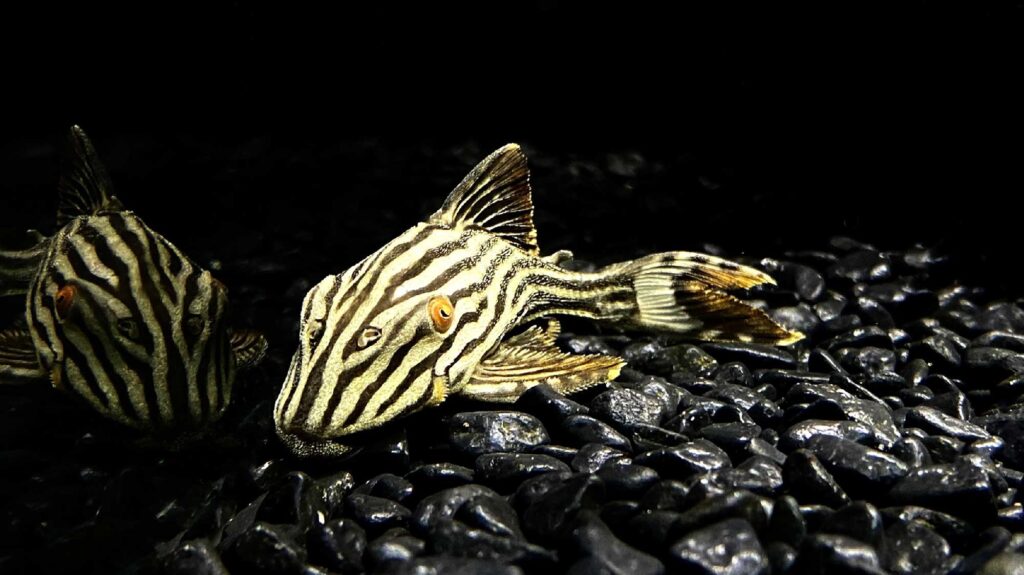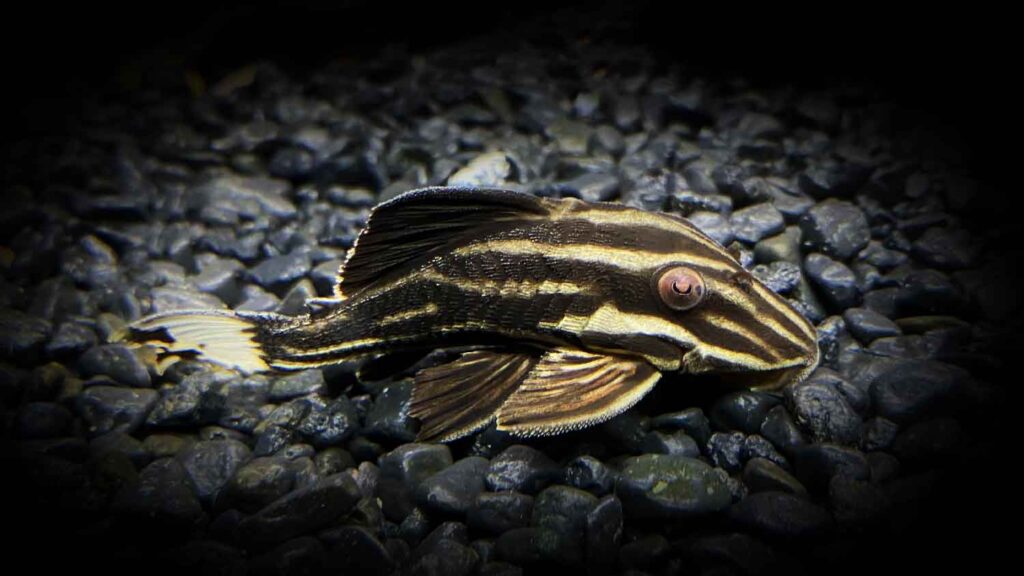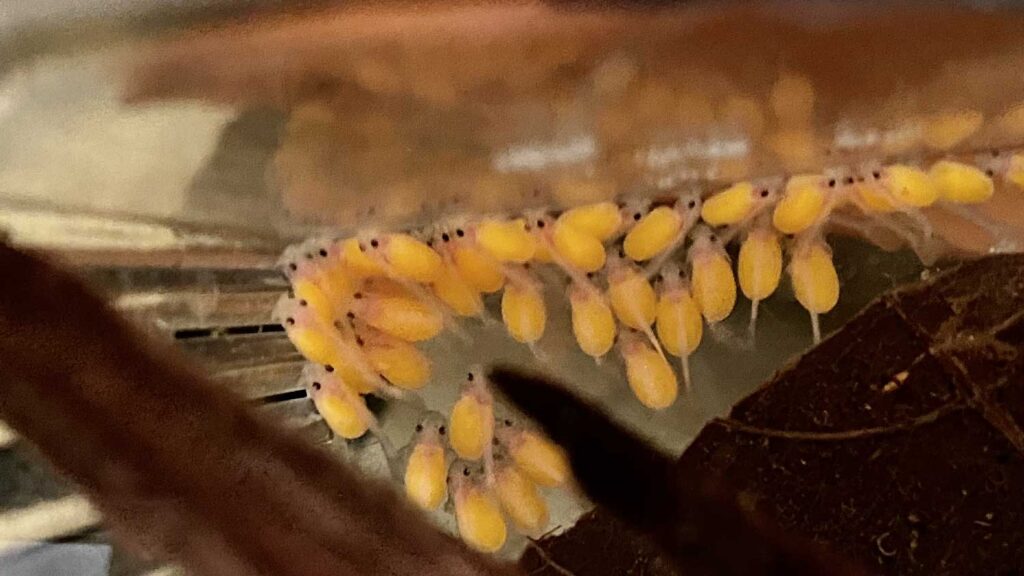The Royal Pleco (Panaque armbrusteri) are unique-looking freshwater fish that are also known as L027 Pleco. They are beautiful fish with amazing patterns that make them very different from other fish in the pleco family. Caring for this species is relatively straightforward and will not take up a lot of your time. They’re easygoing, friendly, and pretty aquarium species that will not bother other fish in the tank.
This guide on Royal Pleco care will provide you with all the information you need about this species.
Species Profile & Overview
The Royal Pleco (L027 Pleco) is a large armored catfish that is found primarily in the Tapajós River in Brazil. Their unique patterns and size make them a good choice for anyone who likes to add a different look and feel to their tank.
This pleco might go by many names online and in pet stores, but they all have similar markings and coloration. They have a flat body coated with bony plates on the back that protects them. These fish are not very common in pet stores and might only become available once in a while. This means they are fairly pricey compared to more regular types of plecos.
As mentioned, the L027 Royal Pleco is a popular aquarium pleco that might not be available at pet stores at all times. This is because this fish is being collected directly from the wild. Fish exporters can only collect this fish at specific times of the year due to changes in the Tapajós and other rivers this fish lives in. The river they are coming from has clean waters with lots of wood, rocks and plant matter with sandy and muddy substrate. The water is warm throughout the year and oxygen levels are always high.
L027 Plecos are known for their large size, which makes them an ideal fish for large aquariums.
Appearance:

The famous Royal Pleco is a beautiful fish that will draw every viewer’s attention. The contrast between their base color and their dark strips makes them look absolutely beautiful in any tank.
As you can see in the picture above they share the same external anatomy as other plecos. They have a suckermouth that is beneath the head under their soft belly. They use their mouth to attach themselves to objects. Their body is wide and bold in the head and belly area but quickly gets slim as it flows towards the tail fin.

They have 8 fins in total, the fins have a triangular shape that shares the same colors and patterns as the rest of the body. Pleco fins, without a doubt, are one of the main attractiveness factors these fish have.
The Dark Black strips cover the entire fish back and fins. When young, these stripes appear more thick and might be broken but as they age, they become more thin and uniformed. A proper diet and care will bring out there patterns even more.
Adult Size
When fully grown, the average Royal Pleco size is around 15 – 16 inches in length. This makes them one of the larger pleco fish that are available in the hobby.
Providing clean water and a diverse diet will encourage this fish to grow faster and maybe even bigger. It is extremely important to properly care for them when they are young and developing so they reach their full potential.
Lifespan
In mint conditions, L027 Royal Pleco lifespan is about 10 – 12 years. Throughout this time they need clean water and a good diet.
Bad diet, low water quality, and stress will reduce the life expectancy of this beautiful fish.
Behavior and Temperament
Royal Pleco are generally very passive and calm that mind their own business at all times. They usually stay in their small territory at the bottom of the aquarium without paying any attention to fish swimming in the water column.
They are mainly nocturnal fish and will mostly come out at night. However, they will also come out during the day when conditions are in their favor.
Males are very territorial and protective of their space and their caves and there might be a fight happening if another bottom-dweller fish comes in or around their space. While they are generally peaceful fish, you might want to keep an eye on them if you have more than one male in the tank.
In order to prevent aggression, you will need to keep them in an aquarium that has a larger bottom area and lots of hiding spots are available. Each male will need to have a cave that is not so close to other caves.
Royal Pleco Care
Royal Pleco care isn’t challenging. Despite coming directly from the wild, these fish will easily adapt to life in the aquarium. However, you might need to make a few tweaks to your fish tank so they can live happily in your aquarium.
In an aquarium, this fish needs pristine water that matches its natural habitat. They will also need a rich diet that provides all the elements they need to thrive. You should always focus on maintaining ideal water parameters in the tank.
The basic guidelines we’ve listed below will help you create the best living conditions for your Royal Pleco.

Tank Size
The minimum tank size for a single Royal Pleco is 60 gallons. However, these fish will need bigger space if you have a community tank that is heavily stocked with other fish. Ideally, a 120 gallon aquarium makes a great living space for a community tank that also houses this fish.
As mentioned, when you want to have more than one L027 Plecos, you will need to acquire a larger tank. Like All bottom-dwellers, these fish need more floor space so the tank’s gallons is not always the best way to calculate how many plecos you can house.
Picking a wider tank is recommended for Royal Pleco as they mainly stay at the bottom of the tank and rarely swim in the water column. Wide tanks will provide more floor area and make it easy for you to add more decorations to create even more floor surfaces.
Adding tiles, slate stone, rocks, and driftwoods will create more surfaces for the fish to swim and hide.
Tank Setup:
To recreate the natural habitat of Royal Pleco in your aquarium you will need a few items in the tank. These fish are bottom dwellers so you need to pay attention to the type of decorations and the substrate you place in the tank.
Placing a large amount of driftwood and rocks will provide enough hiding spots for your pleco to feel safe. Having natural wood will help you maintain a balanced aquarium while providing a source of food for your Royal Pleco.
Royal Plecos also needs caves to hide and sleep when the aquarium lights are on. You can make your own caves or simply buy specially made pleco caves. In our experience, the commercially made pleco caves are the best option as they are designed specifically for plecos.
L027 Pleco’s natural habitat has a fine sand and muddy substrate. In the aquarium, you can use sand as your substrate, this will protect their soft belly from getting accidentally injured. You can also use smaller pea gravel substrates, their round and cornerless shape will not harm your fish but are not as comfortable as sand..
Having live plants will help you create a more balanced aquarium. Most plants will do fine with Royal Pleco so pick a few of your favorites and make your tank look astonishing.
Water Parameters:
Royal Pleco prefers warmer waters that are slightly acidic. They need constant water parameters, long term fluctuations in the tank will lead to stress and disease. The good news is that they are hardy and will easily adapt to a range of temperatures, pH balance, and hardness. The best course of action for these fish is to replicate their natural habitat in your tank.
Below are the tank parameters you can keep L027 Plecos in:
- Temperature: 72 – 80 Degrees Fahrenheit
- PH: 6.5 – 7.5
- TDS: 60 – 120 PPM
A TDS (Total Dissolved Solids) meter is your best friend when it comes to keeping plecos. The TDS meter will let you know how much dissolved solids are in your tank’s water. Every time your tank’s TDS crosses the ideal range you will need to change the water so the TDS goes back down. While other parameters like PH and GH are very important too, we believe TDS and heat are things even beginners should track. As you learn more about fishkeeping you can slowly track Ph, GH, KH, etc…

Lighting:
Royal Pleco thrives in the shade, so if you don’t have live plants, avoid using strong lighting. If you keep live plants, however, you can simply add more caves and hiding spots for them to hide while the aquarium lights are on.
Filter System:
Royal Pleco requires strong filtration, thus we recommend purchasing the most powerful filter available. Most people might argue that larger filters are overkill, but we believe it ‘s better to be safe than sorry! Larger filters will keep your water sparkling clear and can withstand ammonia surges far better than smaller filters.
Common Diseases and Prevention
Like all other aquarium fish, when tank parameters are not in favor of Royal Pleco, they tend to easily get sick. They are also vulnerable to all common aquarium diseases that any new fish might carry into your tank.
In order to prevent diseases, you will need to keep your tank clean and never leave any uneaten food in the aquarium to rot. Always quarantine new fish before adding them to your tank. New fish that are coming from pet stores or other people’s tanks are usually the main transporters of diseases. Properly quarantining and treating these fish will prevent any parasites or diseases that they might carry.
Diet and Feeding Requirements
There are several types of foods that you can feed Royal Pleco. This makes them one of the easiest plecos to feed. They are mainly wood eater plecos that will also eat algae, plant matter, and fresh vegetables.
That said, driftwood is the most important decoration you will need to have in the tank. In the wild, these fish feed on multiple different types of wood so you will have to buy a few different types of wood for them.
These omnivorous fish should receive a plant-rich diet with low amounts of high protein foods. You can feed your pleco live or frozen foods like bloodworms, brine shrimp, tubifex, and other protein foods once or twice a week.
Commercially made foods like sinking pellets, algae wafers, and shrimp wafers should be the main food they receive daily. A good mix of these dry foods will provide your fish with all the nutrition it needs. You can also feed fresh vegetables like zucchini, cucumber, peas, and green beans for optimum health and beauty.
Make sure to feed your Royal Pleco at night. These fish are shy and passive so they will come out to feed when other fish are resting. Dry commercially made pleco foods are the easiest way to feed them. These fish foods will easily sink and have most of the elements your L027 Pleco needs in its diet.
Breeding Royal Pleco

All Royal Plecos that are available to hobbyists are wild caught and they have not yet bred in captivity. This fish needs a very specific environment to breed and re-creating that in an aquarium is not an easy task. This is why this fish has not yet bred in captivity.
If you still want to try your luck and try to breed them, here is what we know about breeding this family of fish:
In order to breed these fish, you will need your Royal Plecos to be mature and at least 3-5 years old. Once you confirm you have at least one male and one female in your breeding group, you can start to condition your fish for breeding.
These fish are wood eaters and are found breeding in caves and crevices made in the fallen logs and driftwoods. So you will need to make a cave made of wood at the right size to increase the chances of them breeding..
You will also need to change their diet to a high protein live or frozen foods. High protein foods will encourage the female to develop eggs. When females develop eggs they become more round and that’s the time the male will start to fan the cave and wait for the female.
Water parameters and conditions of your tank have to change to what’s happening in the Tapajós river during the dry and rainy seasons. This is probably the hardest part to recreate.
Royal Pleco Tank Mates
Luckily the Royal Pleco can live with plenty of tank mates. They are very peaceful plecos and usually will not disturb other fish that live in the tank. Tank parameters are one of the main factors you need to check before selecting tank mates.
Selecting Tank mates for L027 Pleco is very easy, most South American fish can happily live with this species. However, you will need to make sure all your fish can live in the same water parameters inside your aquarium. Fish like African cichlids that need high ph or large and aggressive fish are not ideal tank mates for Royal Pleco.
Here are some good tank mates worth considering:

Conclusion
The Royal Pleco is a fantastic choice if you’re looking for a low-maintenance freshwater fish. This species has gained popularity among aquarists for its peaceful behavior and ease of care. Their unique appearance makes them one of the most fun fish to watch in the tank.